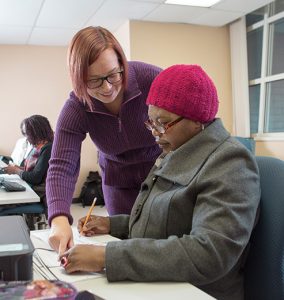This essay by Jennifer Lockwood-Shabat first appeared on MomsRising.org on August 30, 2015.
As the head of a foundation focused on building economic security for low-income women and girls in and around the District, I’m glad that this minimum wage conversation is happening. But in the same vein, I must ask: Why are we focusing on just the minimums, rather than channeling our efforts toward maximizing economic opportunities for our women and girls?
More than ever befor e, low-income working mothers in our region are the sole or primary breadwinners for their families. We must be more res
e, low-income working mothers in our region are the sole or primary breadwinners for their families. We must be more res
ponsive to their efforts to get ahead, we must look beyond the discrete issue of take home pay to see all of the barriers standing in their way:
- Lack of affordable child care. Today, if you are a mother working a full-time, 40-hour workweek under the new minimum wage in the District (thereby making $21,840 per year) it is literally impossible to cover the average annual cost of childcare in our region ($22,000 per year). Under these circumstances, a working mom might resign herself to quit working altogether, or face termination after taking time off to care for a sick child.
- Lack of access to banking or credit. According to CFED, the Washington, D.C./Baltimore area ranks within the top 10 most “unbanked” places in America. Not having a bank account prevents people from saving for and investing in the future and limits their ability to borrow money to buy a house or start a business.
- Lack of access to education and internship experiences that pave the way to jobs with better benefits. By 2022, 44 percent of jobs created – the kinds of jobs that provide living wages for women and their families – will require post-secondary or associate degrees. And too many low-income women in our area aren’t positioned to secure these jobs.
For all of these reasons we must focus our efforts on maximizing opportunities for girls before they even reach working age. Rather than striving for bare minimums, we must show young girls what’s possible – including showing them what their own mothers can achieve. My foundation has been investing in a pilot program of this model: a partnership between College Success Foundation-DC and YWCA of the National Capital Area. This program provides a curriculum designed to support girls’ education and on-time grade progression, leadership development, and healthy choices, while also connecting their mothers to education and job training.
We also support a number of local organizations, including Capital Area Asset Builders, who provide educational and asset building opportunities to our region’s women. Among its many other offerings, CAAB provides financial education and one-on-one financial coaching to low-income women. Graduates of the program report that they are better able to develop regular savings habits, understand how to develop emergency savings plans to buffer against setbacks, and even understand how take concrete steps toward building their own small businesses – all important components of building their economic security.
This Labor Day, let’s keep the conversation going on minimum wage, but let’s also make a commitment to provide the educational and workforce development opportunities that empower all working women to thrive.


